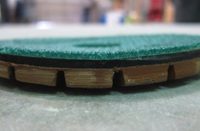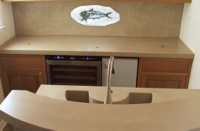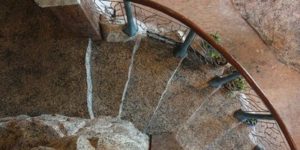
How strong do concrete countertops have to be? I hear that question from fabricators all the time. The answer is not a simple one. It depends upon how you define strength, what your intended use is, and your sealer choice and if you choose to use glass fiber for reinforcement.
Let’s first consider how you define strength. Standard wet-cast concrete’s flexural strength is roughly 10 percent of its compressive strength. Compressive strength is strength when being crushed, and flexural strength is strength when being bent.
We ordinarily only hear about the compressive strengths of concrete. Compressive strength indicates the amount of force in pounds per square inch (psi) it takes to cause a sample to fail when being compressed. Flexural strength is strength in bending and is tested by making and breaking concrete beams. It’s also measured in psi.
Flexural strength
The first time I heard about flexural strength was when we were paving airport runways. I’m sure compressive strength was part of the equation, but flexural strength was the important factor. You simply cannot gain a lot of flexural strength by making superstrong concrete. The difference in flexural strength between compressive strengths of 5,000 psi and 10,000 psi is only about 500 psi.
We have been able to raise standard wet-cast concrete’s flexural strength to 20 percent of its compressive strength through the use of specialized additives, but this is the exception rather than the rule. Fortunately for us, someone has thought of other ways to increase flexural strength without resorting to compressive strengths of 100,000 psi. Internal reinforcement was developed. A low-grade steel bar yields about 30,000 psi (grade 30 rebar), while a high-yield prestressing strand will yield about 270,000 psi. Perfect glass fibers have strength of about 500,000 psi while glass windows have strength of about 7,000 psi, so as you can see there is quite a variation even among similar materials. To gain flexural strength, concrete countertop makers generally use a combination of fiber and steel in wet-cast concrete or glass fiber for reinforcement in GFRC concrete.
Why does your concrete need to achieve greater concrete strength?
1. For easier handling in the shop
You need to be able to strip and process your tops without breaking them. With either wet-cast concrete or GFRC, strengths of 3,000 psi are adequate for handling in the shop if you are careful.
2. To avoid warpage or curling
Curling occurs for a couple of reasons. One is faster moisture loss from one side of the piece than the other. The solution to this is simple: Hydrate more of the cement before you strip the piece. By the time you cross a strength threshold of 4,000 to 5,000 psi, enough of the cement has been hydrated to reduce the porosity of the concrete to the point where exiting water will not cause appreciable shrinkage. Remember, density is directly proportional to strength.
Another cause of shrinkage is low-strength concrete being exposed to moisture, such as during polishing. Here, the porosity of the concrete is not low enough to prevent water from entering the pores and causing one side of the slab to lengthen.
The solution in both cases is simple: get the concrete stronger (and denser) before you strip it. How you accomplish this is up to you. I prefer to use heat while it’s retaining moisture, to speed up the process and get things stripped sooner.
3. When polishing
When you are polishing concrete (to any depth) you need to be able to cut the sand grains rather than pull them out of the matrix. Dislodged sand grains get under the polishing pad, turning a 200-grit pad into a 10-grit pad. Your concrete will never take a polish if it’s not strong enough. There are ways around this, such as densifying the surface prior to polishing. Another solution is to make stronger concrete, since the strength is also needed to solve other problems.
Concrete with standard aggregate needs to be about 5,000 psi to take a very high polish. Concrete with glass aggregate needs to be about 5,500 psi to take a decent polish.
4. For sealers
The majority of topical concrete sealers need a bit of penetration and a mechanical bond with the concrete in order to not delaminate. They will bond fine to 3,000-psi concrete polished to 200 grit. However, most will not bond to 15,000-psi concrete polished to 200 grit. Problems occur when fabricators using topical sealers decide to up the strength of their mix without regard to unintended consequences.
Concrete porosity is directly proportional to strength. Even if the surface of 15,000-psi concrete is honed to 200 grit, the lack of any penetration by most topical sealers may prevent good adhesion. I would not want to be the one telling a customer they can use topical sealer on 15,000-psi concrete polished to 3,000 grit. You’ve created a glasslike surface, and now you’re trying to paint it. (True penetrating sealers will work on just about any concrete.)
The introduction of nanotechnology has solved a lot of the adhesion issues while creating others. There are sealers with nano-sized particles that actually require dense, high-performance concrete to perform. At Trinic, we make a sealer composed of particles measuring less than 1 nanometer (the definition of a nanoparticle). You could pour a gallon of this sealer on a sidewalk block, and it would disappear, eventually wetting out the bottom of the slab. The concrete has to be very dense for this sealer to perform. It does not perform well on 5,000-psi concrete, but it actually works well on glass.
Hybrid sealers bridge the gap between topical sealers and penetrating sealers. The particles are engineered to penetrate mid-range concrete (6,000 psi to 12,000 psi).
Considering flexural strength
Once you have enough compressive strength to polish and seal, we need to switch our focus from compressive strength to flexural strength.
GFRC is the king of flexural strength in all directions. It has compressive strength in the area of 10,000 psi (depending on mix design) and flexural strength in the area of 3,000 psi (depending on fiber and fiber load).
IT GFRC shines when it comes to making complex 3-D structures. There are no worries about how to reinforce GFRC (except for long spans), as the reinforcement is part of the product. However, traditionally, GFRC lacks the range of surface looks available with wet-cast concrete.
The flexural strength of wet-cast concrete is roughly 10 percent of its compressive strength unless installers use special additives. In most cases, this is not high enough to withstand the loads placed on a piece during delivery and installation. Wet-cast concrete requires the strategic placement of reinforcement to resist flexural strains.
Ladder wire may be all that’s required in some cases, but ribs or beams reinforced with rebar may be needed for long spans.
Hybrid mixes
Concrete countertop makers tend to be opportunists and innovators, not bound by convention. Traditionalists would condemn any GFRC mix that fell outside a strict definition of GFRC. However, countertop makers sometimes put glass fiber for reinforcement in wet-cast mixes and aggregate in GFRC mixes. In many cases, these hybrid mixes give the creators the look they want with the compressive and flexural strength they need.
I believe with a little knowledge and implementation, concrete countertop makers can stop making excuses for cracks and other flaws and start delivering a quality product with an endless array of choices.
When your concrete hits certain strength thresholds, it’s vital to understand what it’s doing and why. You can gain clues without testing. Ask: Does it warp? Does it take a polish? Is the sealer acting the way it should?
Even better, do some simple testing. A simple way to test is to cast wet-cast (with larger aggregate) into cylinders or sand mixes into cubes. Find a local lab and get some breaks. It beats walking around in the dark.















